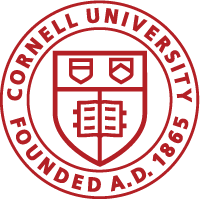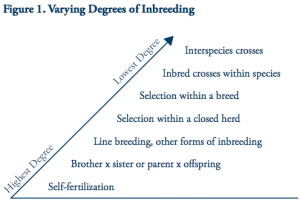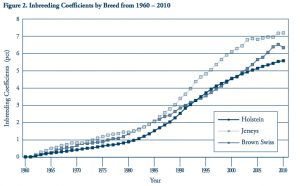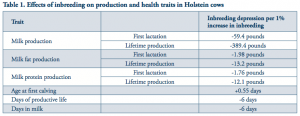By: Juan Du
Inbreeding: breeding of genetically closely related individuals (any sort of relative to relative breeding is considered inbreeding).
- Varying Degrees of Inbreeding
For the purpose of dairy cattle reproduction, the highest level of inbreeding is either breeding between full siblings or breeding parents to offspring, followed by line breeding and other forms of inbreeding mating strategy, breeding within a closed herd, breeding within a breed, and, finally, the lowest level of inbreeding is breeding with a different breed unrelated individual.
Different mating strategies ranked from highest level of inbreeding to lowest: linebreeding > linecrossing > backcrossing > topcrossing > outcrossing > outbreeding
- Current Inbreeding Situation of Different Breeds in the United States
The inbreeding coefficient on the Y-axis is measured by the probability that two alleles for any gene are identical by descent (an measurement for inbreeding).
As we can see in the graph, the inbreeding levels of three major dairy breeds (Holstein, Jersey, Brown Swiss) are all increasing throughout the years, especially after a spike around the 90’s, accompanied by the commercial use of AI in the U.S. Because all owners tend to chose a few elite bulls as sires for their entire herds, the dairy cattle population vastly became more inbred.
- The Harmful Effects of Inbreeding on Production
As the table shows, inbreeding has deleterious effects on both the quantity and quality of milk production in dairy cows.
For quantity, inbreeding causes decrease in both average dairy milk production and the days of productive life in cows, leading to a decrease in total milk production. As inbreeding increases merely 1%, lifetime milk production drops roughly 400 pounds in dairy cows.
As for quality, both milk protein and milk fat production drops as inbreeding increases.
Aside from production, inbreeding also has negative effects in health. Inbreeding would cause an increase in recessive diseases. Only individuals with two identical disease allele would be affected by the disease, individuals with only one disease allele could appear to be normal. Thus, two appearing health parents would result in diseased offspring unless genetic evaluation is done for every individual.
- Ways to Minimize Inbreeding While Maximizing Production
- Keep good pedigree record. In this way you will know which individuals in your herd is related to which, thus minimizing inbreeding by avoiding mating related individuals
- Use genetic material to calculate inbreeding coefficient. In case you do not have good pedigree records, you could still calculate the relatedness between two individuals by using their genetic material (blood/hair sample).
- Utilized mating software that helps control inbreeding. In case you do not want to do all this work on your own, you do not know to calculate relatedness, or you do not want to spend time planning every mating, you could also buy mating software to help you minimize inbreeding. Many companies (Genex, Accelerated Genetics, etc.) provide software that generate the inbreeding coefficient of a specific sire to your entire herd. Thus, even if the bull is somewhat related to a few cows in your herd, on a larger scale, it is still a good option as a sire for your herd.
Reference:
Mc Parland, S., et al. “Inbreeding effects on milk production, calving performance, fertility, and conformation in Irish Holstein-Friesians.” Journal of Dairy Science 90.9 (2007): 4411-4419.
Dairy Cattle Reproduction Council. Implications of inbreeding in the dairy industry, [Online] Available from: http://www.dcrcouncil.org/wp-content/uploads/2017/04/Implications-of-inbreeding-in-the-dairy-industry.pdf [Accessed 12th May 2015].



